![Jerry Hammes.com [Logo]](../../../images/logo.jpg)
|

|
Coach Knute Rockne - 1918-1930
[Back to topic list] [Back to Notre Dame - Jerry & Dorene Topic] 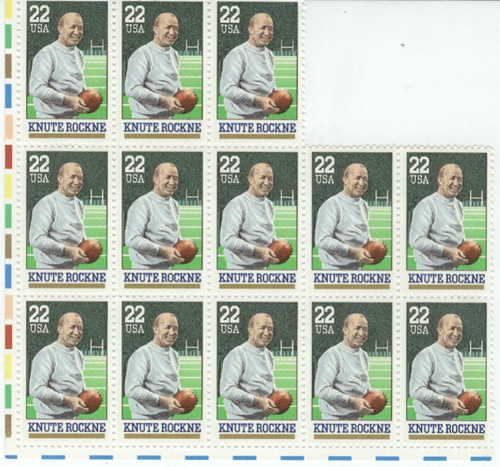  Coach Knute Rockne, far left, met with Studebaker dealers of northern California in San Francisco. In this picture he is met by two Pacific Coast football coaches, Adam Walsh and "Nibs" Price of the University of California. Photo courtesy of the author. Rockne: The coach and the car He was best-known, part-time worker for Studebaker BACK IN TIME ANDREW BECKMAN On May 1, 1928, a middle-aged gentleman entered into part-time employment with the Studebaker Corp. This man was arguably the most well-known, part-time worker on the Studebaker payroll, for on that day, Knute Kenneth Rockne began an association with Studebaker that would last until his premature death in a plane crash near Bazaar, Kan., in March 1931. In the late 1920s, Paul Castner was the sales manager of the commercial division at Studebaker. He had been an All-American fullback on Rockne's 1922 squad and had remained close to the coach after his collegiate career. At this time, Rockne was rapidly gaining recognition as one of the nation's foremost motivational speakers. Castner was well aware of Rockne's prowess as an orator and urged Studebaker Vice President Paul Hoffman to put Rockne's skills to use for Studebaker. The coach was initially retained as an assistant sales manager for $5,000 annually. However, Rockne's popularity was so overwhelming that in 1930 Hoffman doubled his salary. Quite a public speaker Rockne's first speech was to the National Automobile Chamber of Commerce at the Commodore Hotel in New York City. Among those in attendance were Henry Ford, president of Ford Motor Co., and Alfred Sloan Jr., president of General Motors. Castner traveled with Rockne to the black-tie event and recalled a concerned Rockne asking, "What am I going to talk about?" By the time Rockne concluded his remarks, the normally sedate crowd was on its feet cheering and clapping, including Ford and Sloan. Another speaking engagement for Studebaker took Rockne to Spokane, Wash. Clipper Smith, one of Rockne's former players, picked up the coach at the train station in a new Cadillac Smith had borrowed from the local dealer. A photographer from the local paper was also present and busied himself taking pictures. In each photograph, Rockne managed to obscure the Cadillac logos on the automobile by carefully positioning himself in relation to the car and the photographer. When queried by Smith, Rockne replied, "I'm out here representing Studebaker. I can't be seen riding around in a Cadillac!" The coach then instructed Smith to take a discrete route to the hotel, and pulled his hat down low to obscure his identity. Seeking a 'volume leader' Despite Rockne's energetic oratories, Studebaker sales plummeted during the Great Depression. Studebaker's traditional offering of medium-priced automobiles faced stiff competition, and the company lacked a "volume leader" low-priced car. Studebaker had tried to enter the low-price field in 1927 with the Erskine. Named after Studebaker President Albert R. Erskine, it debuted with tremendous fanfare but failed to live up to expectations. As the Depression worsened, fewer and fewer people could afford a new automobile. Those that could were opting lower-priced models. Albert R. Erskine was well aware of Studebaker's flagging sales and continued to investigate adding a low-priced car to the Studebaker lineup. Ralph Vail and Roy Cole were two independent automotive engineers with a small office in Detroit. The pair had been contracted to create a new low-priced car for the Willys-Overland Corp. of Toledo, Ohio. Two prototypes were completed and shown to the Willys-Overland board of directors in early 1931. The cars received an enthusiastic response from the board, but Willys-Overland lacked funds to produce them. Vail and Cole smartly sought and received approval to keep all the rights to the automobiles as well as the two prototypes. Each man took one car and promptly headed on vacation. Ralph Vail owned a farm near Michigan City. His journey from Willys-Overland's headquarters in Toledo, Ohio, took him right through South Bend on a Saturday afternoon. With nothing to lose, Vail visited the Studebaker administration building and managed to arrange a meeting with Studebaker President Albert Erskine that very day. Erskine was impressed with Vail and his automobile, and before the sun had set he hired both Vail and Cole and slated their new car for production. With that agreement, Erskine had his low-priced car, and the Rockne automobile was born. Rockne Motors Corp. was created in 1931 as a wholly owned subsidiary of Studebaker. Production would take place in Detroit at Studebaker's Piquette Avenue plant. Knute Rockne was to have been an officer of Rockne Motors, but accounts differ as to what role he would have taken. All of Studebaker's remaining resources were put into the production and promotion of the Rockne. Knute Rockne did not live to see that car that bore his name. On March 31, 1931, Rockne and eight passengers boarded a flight from Kansas City to Los Angeles. Shortly after takeoff, the plane encountered rough weather and crashed in a field near Bazaar, Kan., killing everyone aboard. Car rolls off the line Despite Rockne's passing, the automobile debuted later that year. The Rockne family received 25 cents for each Rockne sold, and just under 25,000 Rocknes were produced when production concluded in 1933. Although the Rockne was Studebaker's volume leader, sales were not nearly enough to purge the red ink from Studebaker's ledgers. In 1933, Studebaker entered receivership, a form of corporate bankruptcy. When the company resumed production later that year, the Rockne was absent from the lineup. The Rockne's Detroit factory was closed, and all production equipment was shipped to South Bend. The Rockne was by all accounts a fine automobile, but could not overcome the harsh realities of the worst years of the Great Depression. Andrew Beckman is the archivist for the Studebaker National Museum  Chicago Tribune - March 30, 2003         First home game in new statium. 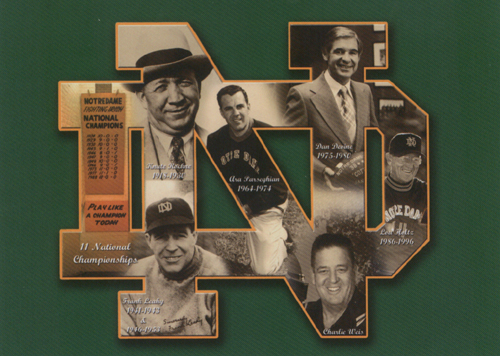   Knute Rockne  This document is located at the Center For History South Bend Indiana    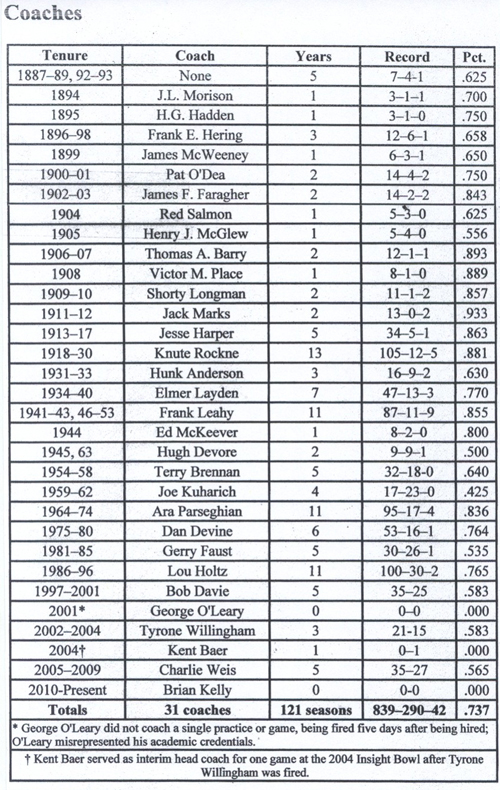 These documents are located at The Center For History South Bend Indiana    The Flight of NC-999 Excerpt from Rockne: The Coach, The Man, The Legend by Jerry Brondfield 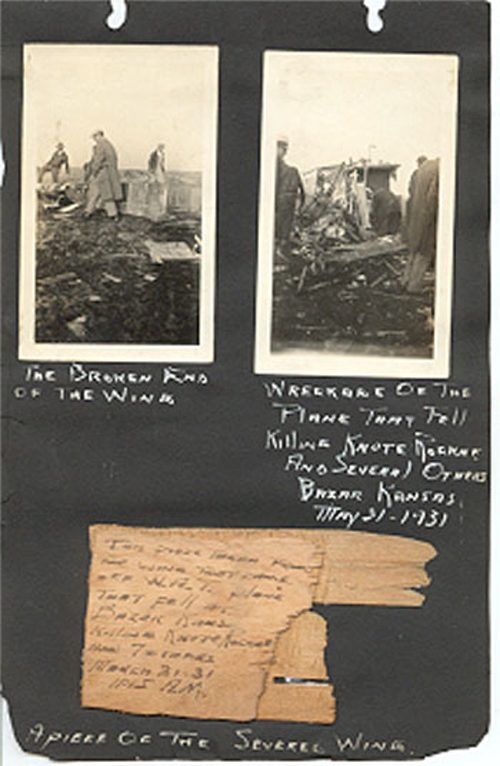 The deep-red and silver F- 10 Fokker monoplane sat damply on the runway at Kansas City, Missouri, rivulets of water running over its striated metal fuselage as a cold drizzle enveloped it. Its three motors growled evenly, its propellers cutting a glistening circle in the drizzle. Tuesday, March 31, 193 1, was a miserable day, and at 9 A.M. the pilot was giving the engines a pre-takeoff warm-up. The Department of Commerce registration number, NC-999, stood out starkly on the tail assembly, identifying the red Fokker as a Transcontinental Western passenger and mail plane. The Fokker could accommodate ten passengers, five on each side, with a narrow aisle between. Its destination was Los Angeles. Takeoff time was 9:15, with the first stop at Wichita at 10:25. There would be two mail stops between Wichita and L.A., but no other passengers were scheduled to board NC-999 at any stop. For this trip the manifest registered six passengers and sixty-five pounds of mail, plus the pilot and co-pilot. There was no stewardess. Commercial aviation was still in its infancy, and the emerging airlines were yet to discover the merchandising ploy of dazzling, shapely sex symbols aloft. You got aboard, found your own seat and, if you wanted to ward off hunger pangs between stops, you brown-bagged it or stuffed a couple of candy bars in your pocket. So much for creature comforts of airline travel in 1931. The pilot was thirty-two-year-old Robert Fry; his co-pilot, Jess Mathias, thirty-one. No third officer or flight engineer, types like that. There was, however, a moderately reliable radio system between plane and ground points. The Fokker was pretty much up to date in Kansas City. Fry was not only experienced; he had made headlines a few years earlier. In 1928, stationed in China, as a sergeant-pilot in the U.S. Marines, he had become lost over unfamiliar territory and run smack into a raging sand-and-wind storm. It took a cool hand at the controls and a minor miracle to keep from crashing. When he finally made an incredible forced landing, he found himself in territory occupied by insurgent Chinese troops who were warring with the Nationalists-and had no love for American forces. They thought he was a spy, and only his fancy footwork and fast talking convinced them that he shouldn't be shot--or worse-and that he was only a lost aviator who'd like nothing more than to get the hell out of there and they could all still be friends. The incident put him on every front page of America. The six passengers who were to board the Fokker were all men. H. J. Christen, of Chicago, a wealthy designer of department store fixtures, was on his way to the Coast for a reconciliation with his estranged wife; he was also a good friend of chewing gum magnate Phillip K. Wrigley. J. H. Happer, also of Chicago, an executive of Wilson Western Sporting Goods, was on his way to open a branch in Los Angeles. C. A. Robrecht, a produce merchant from Wheeling, West Virginia, was bound for Texas; this was his first plane trip. W. B. Miller, of Los Angeles, was an executive of the Aetna Insurance Co., going home after an Eastern sales meeting. Spencer Goldthwaite, a young New York advertising man, was on his way to visit his parents in Pasadena. Goidthwaite, for some reason, had felt impelled to send an in- nocuous telegram back to his office, probably as an excuse to add an awe-struck afterthought. The wire said: PLANE TAKE-OFF DELAYED BECAUSE OF WEATHER. And then: KNUTE ROCKNE ABOARD. Knute Kenneth Rockne, the sixth passenger, was the coach of the by-then fabled Notre Dame football team, the most famous football coach in the land, and one of the greatest names in all sports history. Rockne was going to Los Angeles on-as usual-several missions. He always had to fragment his time wherever he went. Now he was going to Hollywood to sign a film contract; to speak at and be inducted into the illustrious Los Angeles Breakfast Club; to help J. H. Happer open his new sporting goods division; to speak at a gathering of Studebaker Motor Car regional executives and sales personnel. His West Coast expedition was to last only two hectic days. Then he was to return to Notre Dame, where he was in the midst of spring football drills. He had given the squad a few days off for Easter Week and was anxious to get back to work. From the look of the team, the fall would bring him his third straight undefeated, national championship season. In fact, just the night before, Rockne had visited the offices of the Chicago Tribune, where he'd chatted with sports editor Arch Ward. "We've lost several of our stars," he told Ward, "but I think we can do it again. Frankly, though, I'm a bit worried about Southern California . . ." He had gone to dinner that night in Chicago with two good friends, playwright Albert C. Fuller and Christy Walsh, Rockne's personal business manager. Walsh was a sports entrepreneur who booked speaking engagements for Rockne and a few other leading sports figures and syndicated their articles to newspapers throughout the country. Walsh clucked over Rockne like a mother hen, getting him squared away for his varied meetings in L.A. After dinner, Fuller drove Rockne to Union Station, where Rockne was to take the 8 p.m. Pullman sleeper to Kansas City. It would arrive in plenty of time for his morning plane connection. As Rockne got out of the car and handed his suitecase to a redcap, Fuller waved and shouted: "Happy landings, Rock!" Rockne waved back and grinned, "Thanks, Al, but I'd prefer just an ordinary soft landing." Following his Pullman trip from Chicago, Rockne's train pulled into Kansas City at 7 A.M., on time, Tuesday, March 31. Hurrying to the center of the station, he took up a post near the information booth. His two older sons, Billy, fourteen, and Knute Jr., twelve, had previously left Miami, where they had spent Easter vacation with their mother, and were on their way back to Pembroke School in Kansas City. They were due into Kansas City station at virtually the same time as Rockne, and he was looking forward to a brief reunion before rushing off to the airport. He hadn't seen his sons in several weeks. Impatiently, he looked at his watch. It turned out their train was delayed and Rockne wouldn't be able to wait. He hailed a taxi and started for the airport. The boys' train came in fifteen minutes later. When he got to the airport, Rockne found his plane's takeoff was being held up by incoming mail and the 8:30 departure was rescheduled for 9:15. Heavy clouds massed darkly over the airport and the drizzle had not let up as the six passengers waited impatiently to board. Airport officials and airline representatives discussed the advisability of taking off at all. The weather ahead was even worse than here at the airport. Winter was giving way to spring only grudgingly. But after a few minutes' discussion, the pilot, Fry, made his decision. They'd go. Just before boarding, Rockne turned to another passenger, J.H. Happer, whom he knew quite well, and said: "I suggest you buy some reading material. These plane engines make an awful racket and just about shuts off most conversation." At virtually the same time, Pop Warner, the famed Stanford coach, and Navy Bill Ingram, coach at neighboring University of California, were preparing to leave their homes for Alameda, across San Francisco Bay, where they were to board still another Transcontinental Western plane bound for Los Angeles. The day before, Warner had phoned Ingram. Both were close friends of Rockne. "Hey, Bill," Warner said, "Rock is flying into Los Angeles tomorrow for some speeches and stuff. Let's go down there and needle him a bit." Ingram chuckled and thought it a fine idea. Three hours after Rockne's plane was scheduled to take off from Kansas City, they flew out of Alameda. They planned to be at Rockne's hotel when he arrived, armed with some elaborately planned waggery ... The red and silver F-10 Fokker taxied into the wind, then began to roll down the Kansas City runway as Fry applied the power, water streaming along its sides and from the tail assembly. Six hundred yards down the runway, it began to lift off and start its climb. Within one minute, it was above the sullen clouds and obscured from view below. Almost immediately Fry and his co-pilot, Jess Mathias, began a sputtering radio communication with airport weather observers along their westward route. Reception was poor. Within forty minutes, the Fokker was over the Flint Hills cattle and corn country of southeast Kansas, its propellers ripping through the gusty, wet skies. Wichita was about twenty-five minutes away. At that point, the Wichita tower came on the radio to tell them something, but static was garbling everything. Then Wichita heard Mathias say: "I can't talk now. I'm too busy." There was another snatch of message, not quite decipherable, prompting the Wichita operator to ask NC-999: "What are you going to do?" A worried reply came back: "I don't know." As the Fokker neared Bazaar, Kansas, ranchers and farmers were working in the fields below, feeding their cattle, despite the weather. One of them, Robert Blackburn, looked up. He had often seen and heard the mail planes flying this route, and had given them only cursory glances. This one he could hear but couldn't see because of the low-scudding clouds. Bazaar was a remote village with small ranches and houses dotting the adjacent, gently sloping valleys. Not far away were the long-abandoned ruts carved out by stagecoaches on the rude road headed indifferently for Fort Sill, Oklahoma, in the 1850's and 1860's. History had passed this way and left its mark. Here, too, was where thousands upon thousands of Texas cattle had come up from the old Chisholm Trail, for fattening on Kansas' grassy plains. The area was particularly treacherous for fliers. The surrounding hills contributed more than their share of wayward and bumpy air currents. From Kansas City to Wichita, mail pilots at night followed a route marked all the way by flashing signal lights on the ground. Robert Blackburn, who understood tractors, combines and other mechanized farm equipment, knew about motors, and some- thing about the sound of this plane's engines caught his attention and held it. He looked up sharply, lifting a hand in front of his face against the wet mist. A mile away, Seward Baker, working on his 3,000-acre ranch with his son, Edward, also looked up. So did Clarence McCracken and Charles Carpenter, other farmers nearby. All of them, peering up intently now, saw the same thing. Suddenly, a single-wing red and silver monoplane flashed through the cloud bank, angling sharply but not dangerously so, toward earth. It was as if the pilot were looking for a landing spot. Then, as though the pilot changed his mind, the motors, which had seemed to be missing slightly, roared solidly and the plane started to pull back up. Then its motors definitely seemed to miss again. A slight plume of smoke fluttered behind but nothing too serious. Planes often trailed smoke. For an instant, the Fokker seemed to level off and steady itself as it skimmed along at an altitude of about 1,500 feet. Then the farmers heard a loud noise above the motors. Not an explosion, really. Just a loud bang. A second or two later, they were stunned to see the right side of the monoplane's wing snap off with a sharp report. The plane faltered, like a bird winged by a hunter, then nosed over in a slowly twisting dive, gathering speed as it plummeted toward the ground. Halfway in the plane's descent, the farmers saw five bodies fall free from it, twisting and tumbling in the air like so many rag dolls. The five bodies smashed into the earth not far from each other, at about the same instant the plane ploughed into the ground with a shattering crash. Then there was silence. No further explosion. No flames. The farmers started racing toward the point of impact. All except one. Young Edward Baker started running, instead, two miles to the nearest telephone. The torn wing, fluttering down more slowly, like a willow leaf caught in an updraft, clattered to the ground after everything else had hit. It took more than an hour for ambulances and doctors to make their way over muddy roads to the scene of the crash. The last quarter-mile across the Baker farm had to be slogged by foot. As it turned out, the ambulances weren't needed. Baker, his son and two or three neighboring ranchers were standing mute and helpless as the medical party puffed in. Three bodies were jammed together in the forward section of the plane--or rather what was left of it. They were the pilot, co-pilot and a passenger. Five other bodies lay where they had fallen. A watch on the wrist of one of the victims had stopped at 10:45. The doctors quickly realized that positive identification of the victims was going to be difficult. All were mutilated horribly. One doctor shook his head sadly as he noted that one of the men had a rosary clutched in his hand. The eight bodies were taken to the coroner's office at Cottonwood Falls thirty miles away, where a preliminary investigation would be conducted by the Chase County coroner, Dr. Jacob Hinden. He and an assistant started going through papers on the bodies. "My God!" said the assistant as he stared at some papers held in his trembling fingers. "It looks like this man is Knute Rockne!" The victim was the one who'd been found with the rosary in his hand. Positive identification was made within a few hours by two men hastily called to Cottonwood Falls. One was William L. White, a friend of Rockne's, and the author son of William Allen White, famed editor of the Emporia, Kansas, Gazette. The other, ironically, was Jess Harper, whose ranch was not far from the crash site. Jess Harper had been Rockne's coach at Notre Dame, the man whom Rockne eventually succeeded. By now the word of a plane crash with eight people aboard had been phoned in to Kansas City and flashed over all three wire services-AP, UP and INS. The news broke upon the nation early in the afternoon of March 3 1. Every radio program was interrupted with the bulletin, and many newspaper editors scrambled to get out extras. In Cottonwood Falls three girls at the switchboard of the local telephone office tugged wearily at their plugs as newsmen in New York, Boston, Los Angeles and elsewhere beseeched them for the latest news. Was it really Knute Rockne? When a report reached Cottonwood Falls that one of the passengers, Christen, had been carrying a half-million dollars on his person, authorities hastily sent two deputies to guard the wreckage. The deputies found a chaotic, weird scene out of Dante or Daumier. Six or seven planes had flown in from Wichita, circled the area cautiously and then swooped down to bumpy landings, drawn by the magnet of airmen's curiosity about how and why one of their own had come to grief. Hundreds of people from the towns of Bazaar, Matfield Green, Cottonwood Falls and Strong City were already swarming over the crazily twisted wreckage on the small hilltop, tearing off pieces of fuselage metal for souvenirs. Over everything lay the pervasive stench of gasoline, oil, gouged earth, split wood and torn fabric. Four or five cowboys sat on their horses quietly, observing the grotesquerie without comment, even as more of the curious trudged toward them over the muddy turf from autos and trucks parked two miles away on the back road. Among them were ranchers, their wives, schoolboys and even small children. Nobody ever found the alleged fortune in securities at the wreckage. There was none. At Glendale, California, a Transcontinental Western passenger plane landed, and Pop Warner and Bill Ingram stepped off jauntily, intent on hailing a cab to take them to Knute Rockne's hotel in L.A. They were met at the terminal doorway by an airline representative, who took them aside. Warner murmured, "Oh, my God!" and faltered. Ingram reached out to steady him. They looked at each other helplessly and decided they'd go right back to San Francisco, by train. In the Oval Office at the White House, an aide hurried in to President Herbert Hoover, who, despite his high starched collars, was an avid football fan and had been student manager of the football team at Stanford. Told of Rockne's death, Hoover pursed his lips and then said quietly, "What dreadful, dreadful news." Back at Notre Dame, Frank Carideo, the All-America quarterback on Rockne's 1930 national championship team, was shaving when he heard someone screaming across the hall in his dormitory. He stepped outside to see what it was. A student told him about the radio report. Carideo just stood there, the razor in his hand, unable to move, unable to speak. Downstairs in the same dorm, Marchmont Schwartz, the All-America halfback, was sobbing uncontrollably: "Nobody can make me believe it! It can't be true!" At East Lansing, Michigan, a reporter called Jimmy Crowley from a newspaper office with the news. Crowley, who had been one of the Four Horsemen, was then coach of the Michigan State football team. He said nothing to his secretary, got up, put on his hat and walked to his car in the parking lot below. He started driving along the river road, aimlessly, uncomprehending, knowing only that he had to stay away from a telephone that would be ringing constantly, with people seeking his comment on the tragedy. And the one thing he knew for sure was that right now he wanted to keep his feelings to himself. Down in Annapolis, Maryland, Rip Miller, a star tackle on that same team with the Four Horsemen, was coaching the Naval Academy. It was 3:30 p.m., and he was holding a spring practice session when a Naval officer hurried over. Miller was surrounded by his team as he held up a play chart. "Rip, it's bad news," the officer said, and tersely explained what had happened on the Kansas prairie. There was a moment of suspended animation, as though Miller and the Navy football squad were frozen into some gold and blue tableau. Then, without a word from Miller, without a word from any member of the team, the players abruptly broke from their soundless transformation and, as if on cue, began running to the locker room, knowing instinctively there was no further practice that day. In Chicago, Tug Wilson, athletic director at Northwestern (later Big Ten Commissioner) and a dear friend of Rockne's, was walking down Michigan Avenue. A man came out of a shop scanning the front page of a newspaper. Wilson glimpsed the black headline and snatched the paper out of the astonished man's hands. "Give me that!" he cried. "You're nuts!" the man bellowed and tried to grab his paper away. "You don't understand." Wilson's voice trembled. "You don't understand..." The word had swept the city of South Bend, Indiana, long before the newspaper extras had hit the streets. And a strange thing happened. Stores began to close downtown in midafternoon as if by common assent. People left their offices. Total strangers, passing each other on residential streets, would nod, and inevitably one or the other would say: "Have you heard ... ?" In his office, the mayor called in his secretary and said: "We'll have to get ready. This funeral is going to be the kind of thing no one could ever imagine." 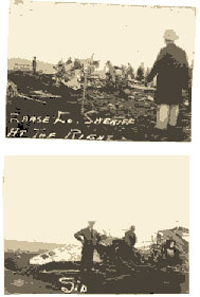       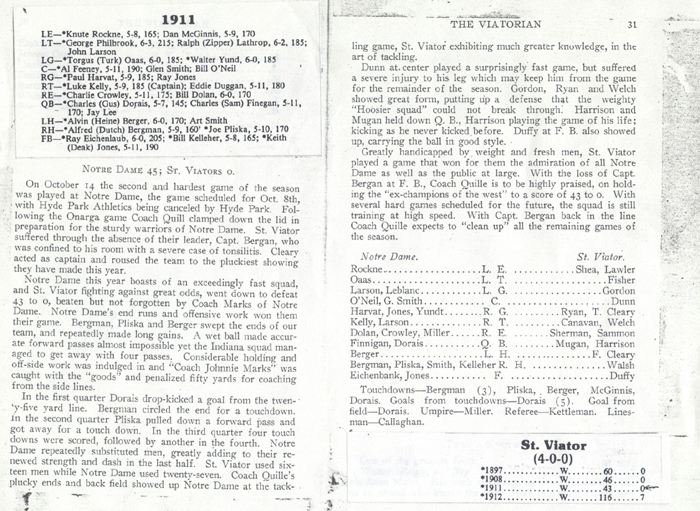       |
 |
 |
 |
 |
 |
 |
 |
 |